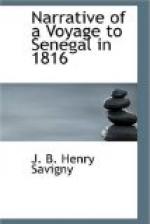The travellers remarked that there was no difference between the very frugal diet of the slaves, who are all blacks, and that of their masters. The fathers and mothers, as well as the marabous, (a kind of priests) pass their leisure moments in teaching the principles of their religion, as well as instructing them in reading and writing on the sand; the wives of King Zaide, the number of whom is considerable, passively obey Fatima, who is the favourite, or chief wife of the sovereign.
Our travellers estimated the number of men, women, children and slaves, at seven or eight hundred persons; their flocks appeared to them very numerous: they constitute part of the wealth of Zaide, who possesses a great many besides, in different parts of the kingdom, the extent of which is pretty considerable; it has about sixty leagues of coast, and stretches to a great depth in the interior of the desert. The people, as we have said, call themselves Trasas, and profess the Mahometan religion; they hunt lions, tigers, leopards, and all other ferocious animals, which abound in this part of Africa. Their commerce is in furs or skins, and ostrich feathers: they manufacture the leather called basil, in french, basane, which they prepare very well;[A11] they make this leather into pocketbooks, to which they give different forms, but in general, that of a sabretache. They also dress goats skins, and join several together to give them more breadth; they are known under the name of peaux de maures, are excellent, and afford a complete defence against the rain: in form, they nearly resemble the dress of a Capuchin; they sell all these articles in the interior, as well as goldsmiths work, which they manufacture with only a hammer, and a little anvil; but their chief commerce, which is very extensive, is in salt, which they carry to Tombuctoo, and to Sego, large and very populous cities, situated in the interior of Africa. Sego




